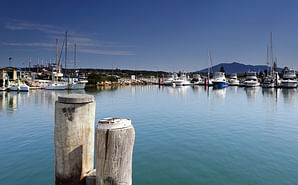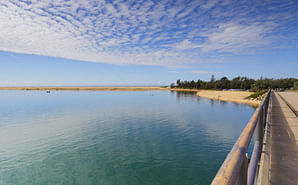Water Catchments
Water catchment areas within the Bega Valley Shire.
A water catchment is an area of land where surface water flows towards and converges to a single point, to join another water body, such as a river, estuary or ocean. A water catchment acts as a funnel by collecting the water within the catchment and channeling it towards a single point. Each catchment is separated topographically from adjacent catchments by a ridge of land called the catchment boundary. Rain falling on either side of a catchment boundary will flow in different directions, in different catchments, towards a different point.
A catchment area is the area of land above a single point towards which all water flows. Smaller catchments, or sub catchments, can be defined within larger catchments depending on the single point chosen as the reference. For town water supply, the location of the source water intakes (river pumps, weirs, bores) is the reference point for determining the catchment areas for each supply system.
Tantawanglo-Kiah water supply system
-
Water source intake point: Tantawanglo Creek weir
Catchment: Tantawanglo Creek
Catchment area: 103 km2 -
Water source intake point: Kiah borefield
Catchment: Towamba River
Catchment area: 984 km2 -
Water source intake point: Bega borefield
Catchment: Bega River
Catchment area: 1,011 km2
Bega-Tathra water supply system
-
Water source intake point: Bega borefield
Catchment: Bega River
Catchment area: 1,011 km2
Bemboka water supply system
-
Water source intake point: Bemboka River pump station
Catchment: Bemboka River
Catchment area: 143 km2
Brogo-Bermagui water supply system
-
Water source intake point: Brogo River pump station
Catchment: Brogo River *
Catchment area: 420 km2 -
Water source intake point: Couria Creek weir
Catchment: Couria Creek
Catchment area: 420 km2 -
Water source intake point: Illwambra Creek weir
Catchment: Illawambra Creek
Catchment area: 19.5 km2
*Brogo River has a large on-stream dam across it to hold back and store the natural flow in the river. Water stored and released from Brogo Dam regulates the flow of water downstream. Brogo Dam has a catchment area of approximately 400 km2 and a storage capacity of 9000 ML. Brogo Dam is operated by State Water and is located approximately 4 km upstream of the Brogo River pump station.
Off-stream dams
Off-stream dams are water storage dams located in strategic locations away from a main stream channel from which water is collected and pumped, or piped by gravity, into the dam. In the Bega Valley Shire there are 3 off-stream dams used for storing water for town water supply – Yellow Pinch Dam, Ben Boyd Dam and Tilba Dam. These three dams are supplied with water pumped, or piped by gravity, from a source water intake. The dams have small catchment areas and rainfall in the dam catchment areas contributes only a minor proportion of the volume of water collected and stored.
Tantawanglo-Kiah water supply system
-
Off-stream dam water storage: Yellow Pinch Dam
Dam catchment area: 0.5 km2
Storage capacity: 8,000 ML
Main source of water for the dam: Tantawanglo Creek
How water is supplied to the dam: Piped from Tantawanglo Creek weir, Gravity flow
-
Off-stream dam water storage: Ben Boyd Dam
Dam catchment area: 0.5 km2
Storage capacity: 800 ML
Main source of water for the dam: Towamba River alluvial aquifer (Kiah borefield)
How water is supplied to the dam: Piped from Kiah borefield, Pumped
Brogo-Bermagui water supply system
-
Off-stream dam water storage: Tilba Dam
Dam catchment area: 0.7 km2
Storage capacity: 90 ML
Main source of water for the dam: Couria Creek
How water is supplied to the dam: Piped from Couria Creek weir, Gravity flow
Water catchments and water quality
The health and good management of catchments for town water supply is important to ensure the quality of water extracted is suitable for the water use needs of the community. Water sourced for town water supply is disinfected with chlorine, however it is not filtrated or treated further chemically (apart from the addition of fluoride for the Bega-Tathra water supply system). As such, the quality of water used in homes and businesses is determined to a large extent by the quality of water sourced from the associated water catchments.
Catchment geology, soils and land use are the most important spatial factors determining the quality of water sourced for town water supply. Water quality is also strongly influenced by whether the water source is a surface waterbody or ground water. Temporal factors affecting water quality include rainfall and river flow and to a lesser extent, season. Another important temporal factor that may affect water quality is whether the water is stored in an off-stream dam prior to supply.
Geology and soils
Catchment geology and soils characterise the water quality, particularly in terms of dissolved solids and hardness. In general the water sourced across the shire is low in dissolved solids (low salinity) and is soft (low hardness). The presence of iron and manganese in the granodiorite geology and associated soils of many of the catchment areas affects the iron and manganese concentrations in the water, particularly groundwater, where low dissolved oxygen and the reducing geochemical environment allows these metals to dissolve and accumulate. Soft water and iron and manganese concentrations are significant water quality issues for the Bega Valley Shire.
Land-use
Catchment land-use characterises the water quality, particularly in terms of turbidity, colour, nutrients and microorganisms (bacteria, viruses, protozoans and algae). Land-use varies for each source catchment as shown in the table below. In general, agricultural, village, rural residential and town areas pose the greatest risk to water quality in terms of nutrients (and associated algae growth in streams and storages), turbidity and pathogens (disease causing microorganisms). Management of these areas is the responsibility of many different organisations and individuals.
Tantawanglo-Kiah water supply system
-
Water source intake point: Tantawanglo Creek weir
Catchment: Tantawanglo Creek
Land Use: Native forest National park and very minor agricultural -
Water source intake point: Kiah borefield
Catchment: Towamba River
Land Use: Mix of native forest National park, State Forest, agricultural, village and rural residential -
Water source intake point: Bega borefield
Catchment: Bega River
Land Use: Mix of native forest National Park, State Forest, agricultural, village and rural residential and town
Bega-Tathra water supply system
-
Water source intake point: Bega borefield
Catchment: Bega River
Land Use: Mix of native forest National park, State Forest, agricultural, village, rural residential and town
Bemboka water supply system
-
Water source intake point: Bemboka River pump station
Catchment: Bemboka River
Land Use: Mix of native forest National Park, State Forest, agricultural (beef and dairy)
Brogo-Bermagui water supply system
-
Water source intake point: Brogo River pump station
Catchment: Brogo River
Land Use: Native forest National Park and very minor agricultural -
Water source intake point: Couria Creek weir
Catchment: Couria Creek
Land Use: Native forest National Park -
Water source intake point: Illwambra Creek weir
Catchment: Illawambra Creek
Land Use: Native forest National Park and very minor agricultural
South East Local Land Services
South East Local Land Services is the statutory body that oversees management of catchment health from Wollongong to the Victorian border. The water sources for all of our water supply systems lie within the Bega Valley local area of the South East Local Land Services region. Bega Valley Shire Council is currently partnering with Local Land Services and other organisations on several projects to help improve local catchment health and water quality.






